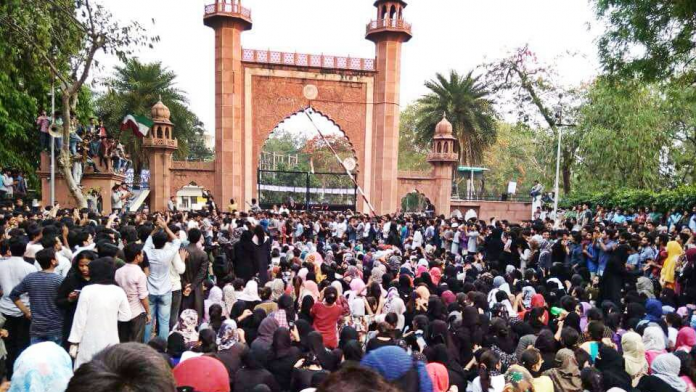
By Haris Rashid
PRIME Minister Narendra Modi recently in his address to Aligarh Muslim University on its centenary celebrations heaped praises on the university and called AMU “mini-India” for its diversity. To endorse his point on diversity, the Prime Minister mentioned some of the languages that are taught in AMU which he then immediately related to religious books. He pointed out that at AMU, if some students receive education in Urdu, others have the option to study in Hindi and if there are students studying and pursuing research in Arabic, there also are students studying and pursuing research in Sanskrit. Modi further added that if the library of the university contains manuscript of Quran, the translations of Gita and Puran have also been preserved with equal care in the library. The Prime Minister created a clear Hindu-Muslim dichotomy the way he mentioned these languages along with the religious books. Through these examples his focus was more on religious diversity and not on the linguistic or social diversity per se.
The implicit association of certain languages with their supposed religions is often taken for granted. Language is a basic human capability for communication that is above religion. Languages do not come from religions that they are commonly associated with. When a religion is born in some place it expresses itself through the language of that very specific place for the convenience of its propagation. Since Islam was born in Arabia where people speak Arabic, the Quran was revealed in Arabic so that it can be expressed and propagated conveniently among the immediate population. Same can be said for Hindu religion which has most holy texts written in Sanskrit.
The association of some languages with their supposed religions, communalizes those languages. The communalization then dictates as to which members of the society are allowed to speak, learn and teach a particular language. It is by the virtue of religion that one identifies with by which a person gets prerogative over a language. It is a coincidence that Modi’s speech in AMU came exactly one year after a controversy engulfed Banaras Hindu University over the appointment of Feroze Khan- a Muslim, as Assistant Professor in the Literature Department of the Sanskrit Vidya Dharma Vijnan (SVDV). A group of students and some members of the Akhil Bharatiya Vidyarthi Parishad (ABVP)-the students wing of the RSS, had led a month-long protest against his appointment in November last year, arguing that he was ineligible to teach in the department because he was a Muslim. The Prime Minister in his speech to AMU reiterated the point that the students in BHU had tried to make: languages are associated with religions and people belonging to one religion do not have the right over the language of other religions.
Languages do not belong to any religious community or a group or even a country. A religion cannot claim to own some language through which it expressed itself. It is just that religions take the help of languages to express themselves. It often happens that when a narrow community claims to own a language, it declines and subsequently vanishes because of the stagnation that follows. In case of religions, when a language gets labelled as “sacred”, it becomes untouchable, resisting the external influence and becomes exclusive. All this keeps a language from keeping up with the progress of the society.
While it is also not entirely true that language was never used by politicians to further their ends but earlier it used to be about regional, not religious matters. Linguistic identity has always been exploited by politicians because it is one of the most common social cleavages from where political parties emerge. Many states in India were created on the basis of linguistic differences and a nation like Bangladesh came into existence solely on the basis of its linguistic identity. Bangladesh also serves a good example as to how language and religion give two separate identities to their people. Although Pakistan had come into existence based on the religious unity of Muslims, people in East Pakistan launched the Language Movement in the 1950’s demanding official status for Bengali language. The movement went on to become the movement for independence of Bangladesh.
Since BJP came into power in 2014, almost everything in India has been communalized and it has come to a point where people’s religious identity is being associated with the food that they eat, the language that they speak and the clothes they wear. The Prime Minister should have been careful with his choice of words. He was there applauding the diversity of AMU but ended up explaining the difference between different languages through the prism of religion. This same method of communalizing each and everything is now often deployed to marginalize and exclude Muslims in India.
- The author can be reached at [email protected]
The views expressed in this article are the author’s own and do not necessarily reflect the editorial stance of Kashmir Observer
Follow this link to join our WhatsApp group: Join Now
Be Part of Quality Journalism |
Quality journalism takes a lot of time, money and hard work to produce and despite all the hardships we still do it. Our reporters and editors are working overtime in Kashmir and beyond to cover what you care about, break big stories, and expose injustices that can change lives. Today more people are reading Kashmir Observer than ever, but only a handful are paying while advertising revenues are falling fast. |
| ACT NOW |
| MONTHLY | Rs 100 | |
| YEARLY | Rs 1000 | |
| LIFETIME | Rs 10000 | |








